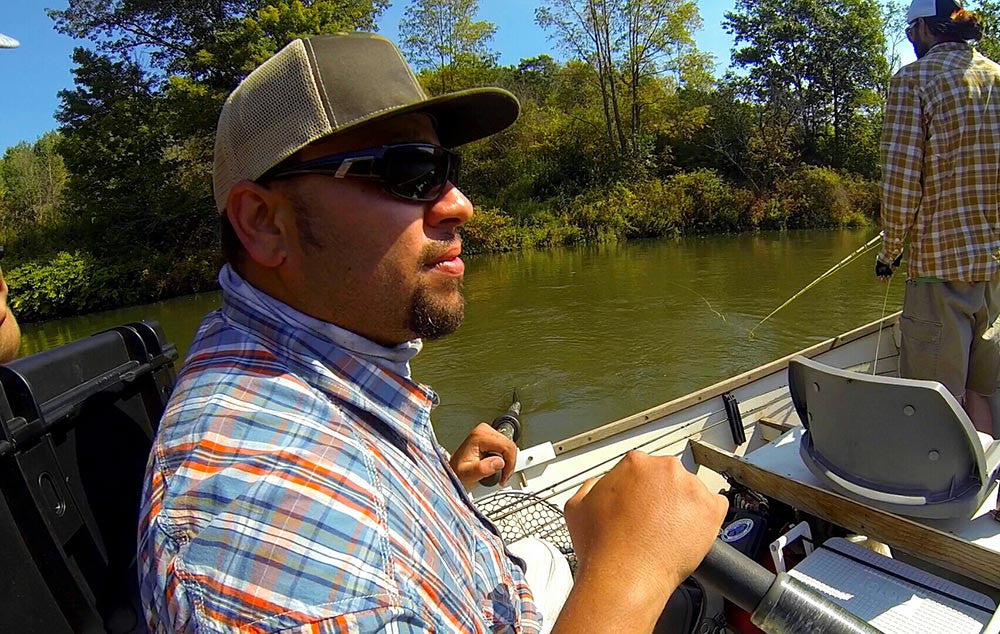Tips from a fly fishing guide: 5 simple things you're probably overlooking.


Flymen guide Ben Rogers of Chasing Tails Fly Fishing.
“Oh, why didn't I think about that?”
I've heard it more times than I can count.
As a fly fishing guide, you become proficient in many aspects. The daily checklists that plague your morning routine become second nature. However, to some fly anglers that are fishing only a few times a month, these seemingly simple to-dos can slip the mind.
Here are five of the best ways to make your day more productive, all of which I've noticed many anglers overlook.
1. Change your leader frequently.

I get it, you only fished a few days with it.
Nevertheless, I make it a priority to change my leaders every time I go out. This should seem like a no-brainer, but it's overlooked more often than not. You should be changing your leader or tippet after every snag or if you remove split shot.
Some anglers go the inexpensive route with their leaders. This basically means you have nylon. Nylon degrades rather quickly and is not abrasion-resistant. I've learned this the hard way.
Fluorocarbon leaders are worth the few extra bucks. They're much stronger and less visible to the fish, which also helps you get away with heavier leader and tippet sizes.
2. Learn your knots.

Early in my career as a guide, one of my first clients was given the nickname Mr. Clinch by the shop owner. No lie, from leader to hook eye, all he used were clinch knots.
Now, I know the clinch knot is time-tested, easy to tie, and generally strong. However, learning your fundamental knots is important in becoming a self-sufficient fly angler. Your leader setup will be stronger and perform better when the proper knots are utilized.
Besides the clinch knot, the most important knots all anglers should know are the improved surgeon's knot, blood knot, nail knot, and a non-slip loop knot. By learning these knots and how they can benefit your rig, you enhance your angling confidence, as well as the ability to know what knot to use to render certain results.
For example, a non-slip loop knot used for nymphs gives a little more freedom of motion. Whether you are tight line, euro, or suspension nymphing, it has shown to help with more technical drifts.
3. Sharpen your hooks!

I cannot stress this enough. Keep your hooks sharp!
You can have on a strong, new leader and do one hell of a hook-set, but it’s all for nothing if your hook point is dull. Most fish have tough mouths, and they only get tougher the older and bigger they get.
It's a habit every angler should have. Whether you buy flies already tied or tie your own, give them a good sharpening before you put them in your fly boxes.
The foam in your box or your fly patch will ultimately dull the hook point. If your fly has been in the water, it's dulling, plain and simple.
Buy a portable sharpener, keep your hooks sharp, and make your hook-sets count.
4. Stop and observe.

When you get to a stretch of water, it takes discipline to delay casting.
It doesn’t matter if you're fishing streamers or not – stop and observe for at least ten minutes. Once you settle down, it’s amazing what you'll see.
Make a strategy of how you'll fish the water you've approached. Take a bio assessment, check for insect activity. Try to spot fish in the water and observe their behavior. Are they actively feeding? Where in the water column are they suspended? Time their feeding pattern. This will make your casts more efficient.
You'll also learn more about that particular habitat as well. You can later make notes of any insect or fish activity you witnessed. This will help you gather an understanding of that area, giving you a greater advantage your future trips.
5. Fish before you step.

We've all heard the saying, “the grass is always greener on the other side”.
When it comes to fly fishing, the opposite side of the river always seems to have a better appeal to most. Fight the temptation!
When you get to a section of water, assume that there are fish right at your feet by the bank. Methodically cast and fish your way to the middle of the drink. If you immediately walk into the middle of the stream or river, you are creating vibrations by displacing water and substrate. This alerts fish to a potential threat, spooking fish that other wise could have been caught. This might also inadvertently put the other fish down that are nearby.
My rule of thumb is cast before you step. I’d rather catch a fish than spook one.
Want more articles like this?
Subscribe to the Flymen Newsletter at the bottom of the page!
About Ben Rogers:
 Ben Rogers is the owner and head guide at Chasing Tails Fly Fishing. He's an ambassador for Soul River – an urban-focused fly fishing company dedicated to conservation of wild steelhead fisheries –, a signature fly tier for Holly Flies, and a contributing editor for various fly fishing publications. After serving in the military, Ben put his specialized skills learned in the Army to good use by working in fly shops and guiding other anglers in the great outdoors and has now been been fly fishing for over two decades. Ben has also volunteered as a guide for Project Healing Waters, working with fellow wounded veterans using fly fishing as a therapeutic tool for recovery, and is a Trout Unlimited member.
Ben Rogers is the owner and head guide at Chasing Tails Fly Fishing. He's an ambassador for Soul River – an urban-focused fly fishing company dedicated to conservation of wild steelhead fisheries –, a signature fly tier for Holly Flies, and a contributing editor for various fly fishing publications. After serving in the military, Ben put his specialized skills learned in the Army to good use by working in fly shops and guiding other anglers in the great outdoors and has now been been fly fishing for over two decades. Ben has also volunteered as a guide for Project Healing Waters, working with fellow wounded veterans using fly fishing as a therapeutic tool for recovery, and is a Trout Unlimited member.


My husband used to go on fishing trips with his dad before his parents divorced, and he wants us to go and try it out again. I like how you suggest to look at what the insects are doing and figure out if the fish are trying to eat them. Your tips seem so helpful, that we’ll just have to find ourselves a fishing guide to help us out. https://fishtawakoni.com/the-fishing/
Thanks for doing these post. This summer I hope to become a kayak fisher. Living in Colorado means trout and more trout. I like camping so maybe I can branch out to some warm water too. : )
I would love to know more about fly fishing to be able to impress my dad on our next fishing trip. Thanks for the tip about the importance of learning the different knots. Another thing that will help is practicing casting before the real thing. http://wyoming.fish/trips.html
I’ve looked over your site, and read your articles. Everything looks great and knowledgeable. I’m a member of Donegal Trout Unlimited and looking forward hearing you speak at our next meeting.
Tight lines,
Bill Nolan
Ben’s a good friend of mine and one of the best fisherman I know. Great advice Ben! If I can offer any more it would be to inspect your tippet often for nicks or stretching and replace if there is any variance, especially with floro. A 10" trout might not be a problem but there’s always the chance for a big one, and that big one will bust your tippet faster than you can blink if it’s not 100% intact. A leader saving tip for using split shot is to keep a tag end off your blood or surgeons knot and attach them to it. I use that technique for steelhead, I run a leader to a small swivel, improved clinch knots on either swivel end and keep the tag end of the leader about 2-3" long and attach the splits to it. It won’t nick your leader, if you get stuck on the bottom the splits easily pull off saving your line and fly and I tend to think it gives a better drift. Last one for nymphing, learn to make your own leaders, it’ll save you money, the straight sections of line will sink faster and you can customize them to the water you’re fishing. Tight lines!
Leave a comment